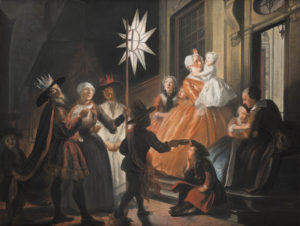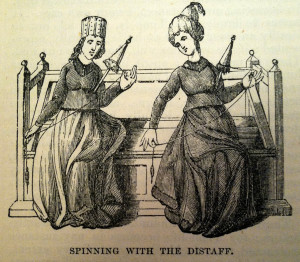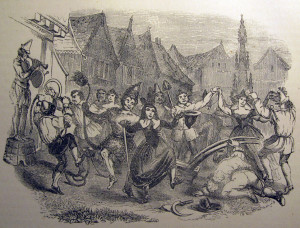
This night of January 5, which is our Eleventh Day of Christmas, brings Twelfth Night, and the celebrations of Twelfth Night roll into Epiphany and the Twelfth Day of Christmas… and thus our Twelve Day carol ends.
ELEVENTH DAY of CHRISTMAS
January 5: Twelfth Night, Eve of the Epiphany
Twelfth Night, earlier in history, was once a really big deal. In England, it was, for a long time, a celebration rivaling that of Christmas Day. But one thing to understand about the history of Christmas, especially in Britain, is that it has always had one foot in the church and one foot in the tavern, and, truth be told, the foot in the tavern was probably heavier than the one in the church. Christmas and all its Twelve Days was a rowdy, boisterous time; it’s no wonder the Puritans despised it so. Even nearly two centuries after Puritan rule, Queen Victoria, who loved Christmas and whose husband, Prince Albert, is credited with introducing the Christmas tree to Britain, was not fond of the boisterous qualities of the holiday, and she had Twelfth Night stricken from the calendar during her reign. She disapproved of its rowdiness and thought her subjects would be better off without Twelfth Night. Her disapproval had a major impact on the celebration and it practically died out. And here we are today, the poorer for this. Especially here in the States, where we tend to just let Christmas unceremoniously fade away.
Ever the champion of the underdog, I am here in my role as a Christmas Traditionalist to champion Twelfth Night, too, for it can be a very useful holiday (no matter what Old Queen Victoria thought of it). If you are inclined toward feelings of melancholy or disappointment after Christmas Day has passed, these Twelve Days––and especially Twelfth Night and Epiphany, which provide a proper send-off to the season––are just what’s needed to help get you through that. For all we talk about maintaining links to the past, perhaps it is this, more than anything, that offers the best reason behind keeping an obscure old holiday like Twelfth Night in our contemporary world. Twelfth Night helps us feel more rounded, more complete. This is the value of Twelfth Night.
My family never did celebrate Twelfth Night when I was younger, but we did mark Epiphany. My mom calls it “Little Christmas.” I do remember one year, when I was a boy, feeling kind of down after Christmas Day had passed, and Mom told me, “It’s ok, we still have Little Christmas ahead.” Our little tabletop tinsel Christmas tree, the one she bought decades ago at Lord & Taylor and which we set up at our house now each year, meant a lot more to me after that. Maybe because the tree is little, just like Mom’s “Little Christmas.”
Years later, after my first internship at the Shaker Press, Brother Arnold Hadd and I exchanged so many letters. In one of those letters, that winter that followed my internship, he wrote about the Shakers’ Christmas celebration. It included things like “shaking the tree” (for presents) and their tradition of a Swedish smörgåsbord (this, a tradition given to them by Brother Ted, whom I never did meet), and yes, Twelfth Night. The traditional English Twelfth Night was a fun filled party with, no doubt, lots of ale and cider and punch, lots of food, and music, dancing, and games. When I picture a Twelfth Night party in my head, it looks a lot like the Christmas Eve party that Old Fezziwig throws for his employees in Charles Dickens’ A Christmas Carol. If you can manage some sort of gathering, and it needn’t be large, well, I think you’d be better for it. We are gathering with family and friends on Saturday evening this time around, for a special meal––crown roast of pork––and some games (including the old Yankee Swap gift game). No fiddler and caller, alas, but still: a proper send off to Old Father Christmas if ever there was one.
In Italy on this Eve of the Epiphany, la Befana will make her rounds, and in Spain and Latin America, los Tres Reyes, the Three Kings, will be doing the same. All of them will be delivering gifts; they are the last of our Midwinter gift bearers. Their stories are intertwined. Epiphany––a celebration older even than Christmas itself––marks the day the Magi arrived after their long journey, following that star, to see the child born in a barn. They arrived with gifts for the child, and so it is no surprise that they are amongst our Midwinter gift bearers. In Italy, though, the legends get a little more interesting, wrapped up as they are with a kindly old witch. There, it is said that the Magi stopped at la Befana’s and asked her for directions and to join them on their journey. They found her sweeping her floor. “No, no,” she told them, “I’m too busy with my housework!” And so the Magi went on their way. But as she swept, la Befana grew remorseful that she had not gone with them, and so she stopped her sweeping, hopped on her broom, and left her home in search of the Magi and the child. But she never found them. Each year on the Eve of the Epiphany, she sets out on her journey again, in search of the child, delivering small presents to good boys and girls, and coal for the not so good ones… but the coal these days is candy and sweet and so even that is not such a bad thing to find in your shoes on Epiphany morning.
I have known lots of Befanas in my day. It comes with the territory when you are of Italian descent. Women and men who clean and clean and clean, and who take great pride in their clean homes. Which is a wonderful thing, of course, but you know that they would’ve said no to the Magi, too, just like la Befana herself did at that first Christmas. Where does she even come from, la Befana? Well, she is an old hag… and so is the earthly goddess at Midwinter in the circular nature of the year: Born in springtime, fair maiden in summer, mother in autumn, old woman in winter. A cycle repeating with each orbit around the sun, another of our stories told again and again since time immemorial.
TWELFTH DAY of CHRISTMAS
January 6: Epiphany, Three Kings Day
On this final day of the Christmas season, we come to a celebration that was recognized by the Church even before Christmas itself. It is the day tradition tells us the Magi reached the stable to visit the child after their journey following the star that guided them to Bethlehem. Seeing the child was their epiphany, and that is the name of this day, too: Epiphany. Why was their day honored even before Christmas was? Probably because Epiphany holds the great symbolism that this news of the savior’s birth was for all people. The Magi are not from Judea. They are from distant lands. By journeying for twelve days and paying homage to the child, the Magi show that the message is universal.
In our home, we close the celebration of Christmas on Epiphany night with a simple ceremony at the front door, outside on the front porch. We will gather up all who are in attendance and we will each take turns writing with chalk on the lintel above the front door the numbers and letters and symbols of a traditional inscription. This year, it will read as follows: 20+C+M+B+24. These are the initials of each of the Three Kings (C for Caspar, M for Melchior, B for Balthasar), punctuated by crosses, blanketed on either side by the year. I tell you this each and every year: For me, the inscribing is always accompanied by a silent prayer that no one will be missing when we gather next to write the inscription again. Depending on the weather, the inscription may be there above the door for a month or it may be there all the year through. And though Christmas be gone, still the inscription reminds us of its presence as we pass each day through that portal. The inscription is a magic charm of sorts, protecting the house and those who pass through the doorway, harboring the goodwill and spirit of Old Father Christmas.
And with that, these Twelve Days of Christmas are done. La Befana is back to her sweeping, sweeping Christmas away, too, and we return to ordinary time, back to the workaday world. The poet Robert Herrick reminds us that it is fine and good, too, to keep the Christmas greenery in your home for the rest of the month of January, and this is something we will be doing. But the major part of the celebration is done, and with that, Old Father Christmas makes his way again to find his rest, until we conjure him back to our homes once more as the year grows old, like he himself.
TWELVE DAYS of CHRISTMAS SALE
Just a couple days left of our Twelve Days of Christmas Sale at our online shop. Through January 6, find automatic markdowns on most of our authentic German handmade nutcrackers, pyramids, and incense smokers, and chocolates and cookies, too. If there are things you wished for that Santa couldn’t fit in his sleigh, well, we’re here to help (and to offer you our best prices of the year, too). CLICK HERE to shop!
Image: Such a fair way to send Father Christmas on his way: “Singing Round the Star on Twelfth Night” by Cornelis Troost. Pastel and brush in gouache on paper, 1740. [Public domain] via Wikimedia Commons.



